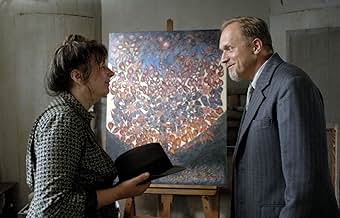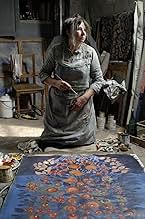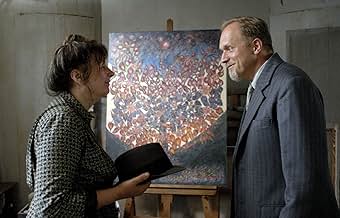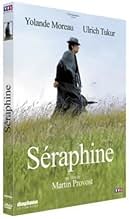CALIFICACIÓN DE IMDb
7.4/10
6.7 k
TU CALIFICACIÓN
Basada en la vida de la pintora francesa, Séraphine de Senlis.Basada en la vida de la pintora francesa, Séraphine de Senlis.Basada en la vida de la pintora francesa, Séraphine de Senlis.
- Dirección
- Guionistas
- Elenco
- Premios
- 20 premios ganados y 10 nominaciones en total
Léna Breban
- Soeur Marguerite
- (as Léna Bréban)
Sandrine Bodenes
- Marie-Louise
- (as Sandrine Bodènés)
Anne Benoît
- Madame Delonge
- (as Anne Benoit)
- Dirección
- Guionistas
- Todo el elenco y el equipo
- Producción, taquilla y más en IMDbPro
Opiniones destacadas
I enjoy French films very much and saw Seraphine in Paris. While the movie looks beautiful and the acting is excellent, overall the film bored me. There wasn't enough dramatic tension or intense character development to sustain my interest. I was very surprised that it won so many awards, but then again if the French academy is similar to the one in the U.S., they tend to play it safe. Seraphine is worth seeing if you are interested in thinking about the artistic soul. But there is nothing groundbreaking here. I would have liked to see a version of this artist's life that was less academic and more thought provoking. The one thing I admired very much was the performance of the lead actress. I was trying to imagine anyone equivalent to her in the U.S. and was unable to conjure any names. She is not classically beautiful, yet clearly she is an actress of great stature in France to have won this role. The lesson I took away from the film was the appreciation of talent, both of Seraphine and the actress who portrayed her.
Séraphine de Senlis - born Séraphine Louis (1864- 1942) - may not be a painter well known to the entire art world today, but the story of her life makes a compelling film. Writer Marc Abdelnour and writer/director Martin Provost have extracted all of the significant aspects of Séraphine Louis' life and have created a work of art as a film, much in the style of the way she created her life in art.
Séraphine Louis (Yolande Moreau) was born in 1864 in Arcy to a poor family and worked as a shepherdess until 1881 when she accepted the position as a domestic worker for the Sisters of Providence in Clermont: her life with the nuns enhanced her profoundly religious approach to her personal philosophy. In 1901 she left the convent, in part due to a communication with her angel that she must paint, to become a housekeeper for middle class families in Senlis. In her quiet manner she scrubbed floors and did laundry by day, using the pittances of income to procure some supplies so that she could paint her images of fruits, flowers, and leaves by candlelight at night in her tiny room. Self taught, she used pigment from strange sources - blood from the butcher, melted wax from the votives at the cathedral, pollen from the flowers of the fields, her only 'purchased' component was gesso and white paint from the artist supply shop in Senlis.
In 1914 the German art collector and critic Wilhelm Uhde (Ulrich Tukur) took a room in the house owned by Mme Duphot (Geneviève Mnich), one of the houses where Séraphine worked, and when Wilhelm discovered a painting by Séraphine he immediately recognized a painter of great promise and provided Séraphine with the first response to her artistic efforts. Wilhelm and Séraphine became friends and Wilhelm bought all of her art, insisting that she devote her time to creating art instead of scrubbing floors. With the backing of a collector and friend, Séraphine began painting in earnest, showing locally and selling art under Wilhelm's sponsorship, until 1914 when with WW I breaking out, Wilhelm had to flee France, leaving behind his collection of paintings as well as the close bond the two had formed. Mistakenly Séraphine thought Wilhelm's departure was to marry his roommate Anne-Marie (Anne Bennett), only to discover that Anne-Marie was Wilhelm's sister and fellow supporter of Séraphine: Wilhelm informed her he would never be able to marry a woman.
Séraphine continued painting as she lead her eccentric life in Senlis and in 1927 Wilhelm returned to France with his paramour - young painter Helmut Kolle (Nico Rogner) who suffered from tuberculosis - rediscovers Séraphine's art in a local Senlis exhibition, and realizes that she had survived and her art had flourished. Under Wilhelm's patronage, Séraphine began painting large canvases as large as two meters high, and she achieved prominence as the naïve painter of her day. In 1929, Wilhelm organized an exhibition, 'Painters of the Sacred Heart', that featured Séraphine's art, launching her into a period of financial success she had never known - and was ill prepared to manage. Then, in 1930, with the effects of the Great Depression destroying the finances of her patrons, Wilhelm had no choice except to stop buying her paintings. Séraphine's spending habits cause concern and in 1932 her psychotic behavior resulted in placement in the psychiatric ward in Clermont hospital where she spent the rest of her days, alone and without friends or admirers of her gift of art.
The simplicity of the manner in which this story is related with very little dialogue, atmospheric scenery as captured by cinematographer Laurent Brunet, and a musical score by Michael Galasso that combines sacred chants with idiomatic instrumental music of French ancestry. Yolande Moreau glows with a special radiance as the simple, spiritual, artistically driven Séraphine and Ulrich Tukar is the perfect balance as his own driven, unique 'first true collector'. This film is a little masterpiece and one that deserves the attention of everyone who cares about the lives of artists and the emergence of genius from strange vessels.
Grady Harp
Séraphine Louis (Yolande Moreau) was born in 1864 in Arcy to a poor family and worked as a shepherdess until 1881 when she accepted the position as a domestic worker for the Sisters of Providence in Clermont: her life with the nuns enhanced her profoundly religious approach to her personal philosophy. In 1901 she left the convent, in part due to a communication with her angel that she must paint, to become a housekeeper for middle class families in Senlis. In her quiet manner she scrubbed floors and did laundry by day, using the pittances of income to procure some supplies so that she could paint her images of fruits, flowers, and leaves by candlelight at night in her tiny room. Self taught, she used pigment from strange sources - blood from the butcher, melted wax from the votives at the cathedral, pollen from the flowers of the fields, her only 'purchased' component was gesso and white paint from the artist supply shop in Senlis.
In 1914 the German art collector and critic Wilhelm Uhde (Ulrich Tukur) took a room in the house owned by Mme Duphot (Geneviève Mnich), one of the houses where Séraphine worked, and when Wilhelm discovered a painting by Séraphine he immediately recognized a painter of great promise and provided Séraphine with the first response to her artistic efforts. Wilhelm and Séraphine became friends and Wilhelm bought all of her art, insisting that she devote her time to creating art instead of scrubbing floors. With the backing of a collector and friend, Séraphine began painting in earnest, showing locally and selling art under Wilhelm's sponsorship, until 1914 when with WW I breaking out, Wilhelm had to flee France, leaving behind his collection of paintings as well as the close bond the two had formed. Mistakenly Séraphine thought Wilhelm's departure was to marry his roommate Anne-Marie (Anne Bennett), only to discover that Anne-Marie was Wilhelm's sister and fellow supporter of Séraphine: Wilhelm informed her he would never be able to marry a woman.
Séraphine continued painting as she lead her eccentric life in Senlis and in 1927 Wilhelm returned to France with his paramour - young painter Helmut Kolle (Nico Rogner) who suffered from tuberculosis - rediscovers Séraphine's art in a local Senlis exhibition, and realizes that she had survived and her art had flourished. Under Wilhelm's patronage, Séraphine began painting large canvases as large as two meters high, and she achieved prominence as the naïve painter of her day. In 1929, Wilhelm organized an exhibition, 'Painters of the Sacred Heart', that featured Séraphine's art, launching her into a period of financial success she had never known - and was ill prepared to manage. Then, in 1930, with the effects of the Great Depression destroying the finances of her patrons, Wilhelm had no choice except to stop buying her paintings. Séraphine's spending habits cause concern and in 1932 her psychotic behavior resulted in placement in the psychiatric ward in Clermont hospital where she spent the rest of her days, alone and without friends or admirers of her gift of art.
The simplicity of the manner in which this story is related with very little dialogue, atmospheric scenery as captured by cinematographer Laurent Brunet, and a musical score by Michael Galasso that combines sacred chants with idiomatic instrumental music of French ancestry. Yolande Moreau glows with a special radiance as the simple, spiritual, artistically driven Séraphine and Ulrich Tukar is the perfect balance as his own driven, unique 'first true collector'. This film is a little masterpiece and one that deserves the attention of everyone who cares about the lives of artists and the emergence of genius from strange vessels.
Grady Harp
A frumpy cleaning woman well into middle age is discovered by an art critic to be a painter with talent comparable to Vincent Van Gogh. Her story is told in the riveting Seraphine, directed by Martin Provost and winner of seven Césars, the French version of the Oscars, including a best actress award for Yolande Moreau. With a screenplay by Martin Provost and Marc Abdelnour, the film is set in the village of Senlis outside of Paris where Séraphine Louis (Yolande Moreau) lives alone and must take odd jobs just to pay for her painting supplies. Séraphine is a visionary, a devout Catholic who believes she is guided by a guardian angel and her exotic paintings of flowers and plants describe her feelings of closeness to spirit.
Treated with disdain by her condescending employer, her life takes on new meaning when a tenant, German art critic Wilhelm Uhde (Ulrich Tukur) hires Séraphine to clean for him and accidentally discovers one of her paintings that her boss had tossed aside. A champion of modern "primitvist" artists who is credited with early recognition of Picasso and Rousseau, Uhde is portrayed by Tukur as a quiet, unassuming man who lives with his sister and a gay lover. He recognizes Séraphine's talent but never shows much enthusiasm, preferring to keep their relationship on a very business-like basis.
Impressed by Seraphine's passionate art, Uhde offers to become her patron but, feeling estranged in France, must soon leave the country to return to Germany as the First World War begins. Although Séraphine continues to paint, she has no connection with Uhde until the latter part of the 1920s when he provides her with the means to quit her job and paint full time. Unfortunately, her grip on reality falters and she is soon hospitalized after indulging in spending sprees on a wedding dress and purchase of a large mansion. One of the saddest scenes in the film is that of Séraphine dressed in a full wedding gown, going door to door giving her away her possessions.
Provost in Séraphine captures the artist's mystical nature and her close bond with nature that shows up in her works, which are still exhibited in many of the world's museums. She is shown hugging trees, climbing them, and standing as a tiny speck beneath a towering shade tree. One scene shows her standing nude in water up to her chest in a nearby river. Provost takes a minimalist approach and the film does not contain much dialogue. The story is told by the silences and facial expressions and the music by Michael Galasso adds richness to the experience. Fully capturing the eternal mystery of the creative process, Séraphine itself is a work of art.
Treated with disdain by her condescending employer, her life takes on new meaning when a tenant, German art critic Wilhelm Uhde (Ulrich Tukur) hires Séraphine to clean for him and accidentally discovers one of her paintings that her boss had tossed aside. A champion of modern "primitvist" artists who is credited with early recognition of Picasso and Rousseau, Uhde is portrayed by Tukur as a quiet, unassuming man who lives with his sister and a gay lover. He recognizes Séraphine's talent but never shows much enthusiasm, preferring to keep their relationship on a very business-like basis.
Impressed by Seraphine's passionate art, Uhde offers to become her patron but, feeling estranged in France, must soon leave the country to return to Germany as the First World War begins. Although Séraphine continues to paint, she has no connection with Uhde until the latter part of the 1920s when he provides her with the means to quit her job and paint full time. Unfortunately, her grip on reality falters and she is soon hospitalized after indulging in spending sprees on a wedding dress and purchase of a large mansion. One of the saddest scenes in the film is that of Séraphine dressed in a full wedding gown, going door to door giving her away her possessions.
Provost in Séraphine captures the artist's mystical nature and her close bond with nature that shows up in her works, which are still exhibited in many of the world's museums. She is shown hugging trees, climbing them, and standing as a tiny speck beneath a towering shade tree. One scene shows her standing nude in water up to her chest in a nearby river. Provost takes a minimalist approach and the film does not contain much dialogue. The story is told by the silences and facial expressions and the music by Michael Galasso adds richness to the experience. Fully capturing the eternal mystery of the creative process, Séraphine itself is a work of art.
An artist. Fragile, gray, small. Some dreams. A fall. And drops of hope. Few images. A mecena. In fact, story of an ordinary existence. Testimony of forms of beauty . Words of a warm confession, with a brilliant Yolande Moreau and an great director. Everything is in best place. Light and cast, details and looks. And the air of small persons , delicate gestures, definition of art and art as refuge are pieces of this movie. So, it is not a biographic film. Seraphines are many men and women, basic instruments for others who believes that life is more than lies and hypocrisy. Beginning for discover of reality without appearance, sad and beautiful, poem about shadows of a fight, word of a late fame, "Seraphine" must be see again and again. In every Senlis lives a Seraphine.
10JustApt
This extraordinary biographical film tells the dramatic story of French paintress Séraphine de Senlis. The tale starts in the summer before the First World War when a known German art collector and critic Wilhelm Uhde accidentally finds out that his servant woman is an amateur artiste painting in naïve but highly innovative and original style. She was doing so because she had a vision of divine being who has told her to begin to paint pictures. Where does genius end and madness begin? Or are they just two sides of the same phenomenon? Questions poised by this artful drama hardly have the answers. To say that Yolande Moreau playing the role of Séraphine Louis is unique is to say the least. Camille Claudel is another brilliant movie in the same vein.
¿Sabías que…?
- TriviaSince the film's release, the number of visitors at the museum of Senlis exhibiting Séraphine's works has quadrupled (August 2009).
- ErroresThe film opens in 1914 showing the arrival of Wilhelm and Anne-Marie at the village. Wilhelm actually arrived in 1912, two years before the start of the war.
- Créditos curiososThe credits list the names of the paintings which are seen in the film - 10 paintings by Séraphine and the artworks owned by Uhde and Kolle.
- Bandas sonorasConsonent laudes!
Written by Louis Rousseau
Performed by Yolande Moreau, Françoise Lebrun and Léna Breban
Selecciones populares
Inicia sesión para calificar y agrega a la lista de videos para obtener recomendaciones personalizadas
- How long is Seraphine?Con tecnología de Alexa
Detalles
Taquilla
- Presupuesto
- EUR 3,674,000 (estimado)
- Total en EE. UU. y Canadá
- USD 884,613
- Fin de semana de estreno en EE. UU. y Canadá
- USD 38,637
- 7 jun 2009
- Total a nivel mundial
- USD 9,402,702
- Tiempo de ejecución2 horas 5 minutos
- Color
- Mezcla de sonido
- Relación de aspecto
- 1.85 : 1
Contribuir a esta página
Sugiere una edición o agrega el contenido que falta

Principales brechas de datos
By what name was Séraphine (2008) officially released in India in English?
Responda

































